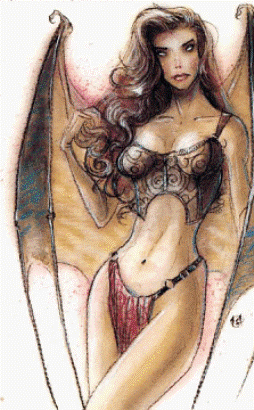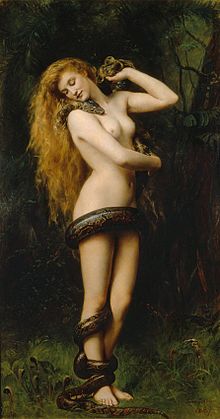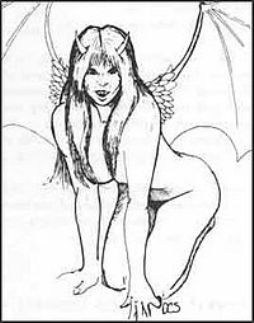Art of the Genre: Art of the Iconic Female #2; The Succubus

I can’t tell you for sure the first time I saw a succubus, but I’d lay money that it was in the 1st Edition Advanced Dungeons & Dragons Monster Manual. The image there, done by David C. Sutherland III, has been the subject of much debate over the years [Supposedly it’s based on this picture of Sheila Mullen, a Playboy Playmate from May 1977], but one thing no one can argue is whether or not it’s sexually inspiring to teenage boys. For that, the answer is an obvious YES!
This sexuality is certainly the key to making the succubus an Iconic Female, and there is little doubt that countless images of feral succubus abound in any fantasy setting worth its salt. For my own fantasy gaming succubus legends, I have a couple, but I suppose my most famous comes not from the succubus herself, but from a succubus’s torrid affair with a Drow wizard that produced an Alu-demon known only as Mithelvarn’s Daughter. This character inspired a deep affection for Alu-demons which first appeared in Monster Manual II and were drawn by Harry Quinn. That tome described them as the offspring of a mating between a succubi and a human, and that these progeny are always female. Cambions, for all you playing a copy of the home trivia game, are the product of a human female mating with a demon, and they are always male.
Still, other than D&D trivia, what do we really know about the succubus other than she’s inherently hot? Well, I did a bit of digging, and what do you know, I found that there is a reason, other than sexual attraction, for me to like a good old-fashioned succubus.
You see, as far as I can tell, Succubi are really old, like the dawn of history old. When you start reading society keywords like Mesopotamian or Babylonian, you know you are getting serious about a demon’s age. In those cultures, they had references to a dream-haunting demon named Lilitu, but it isn’t until the early Jewish faith breaks onto the scene that we find Lilith, the presumed first ‘modern’ succubus, mentioned in the Babylonian Talmud. Here, Adam, product of God that we know in the Christian Bible, takes Lilith as his first wife since she was created from the same earth as he. It isn’t until he breaks with Lilith because she refuses to become subservient to him that Eve is created from Adam’s rib, and therefore a part of man instead of his equal.

Interesting indeed… So in essence, the Iconic Female Succubus is actually on par with mankind instead of simply being cast from his form, and therefore she’s thrown under a bus. The story continues that Lilith hooks up with the archangel Samael and then refused to return to the Garden of Eden. My thought here, ‘Well why should she? She just bagged an archangel for Pete’s sake!’
However, her road to ruin only continues in Jewish folklore from there. In the Zoharistic Kabbalah the tale holds that four different queens, Lilith, Agrat Bat Mahlat, Naamah, and Eisheth Zenunim mated with archangel Samael and became succubi in the process. Now I’m just spit-balling here, but what’s with Archangel Samael? This angel is supposed to be good, right? I mean, isn’t that the definition of ‘angel’, and yet he gets around like a Sunset Blvd pimp, and everyone he sleeps with becomes a demonic man sucker… I mean, I’m just sayin…
Anyway, once Lilith was entrenched in this lore, it took little for the already ‘scrambling to declaw women at all costs’ Christian Church to further her decline into evil. However, there is a great reference in the life of Pope Sylvester II [A.D. 999-1003] in which he proclaims on his death bed that he attained his position as pope with the help of a succubus, so I guess they can’t be all bad, right?
Throughout Europe during the Middle-Ages the succubus was blamed for all manner of dark deeds and birth defects. It was said that the succubus would come to a man in a dream, dressed in the guise of a beautiful woman, and take his seed. Anyone continually partaking of nights with succubi would wither and die, their life drained from them by the vicious and insatiable demon. Yet the story doesn’t end there, as the thieving succubus would pass along the stolen semen of her victims to an Incubi, the male versions of her kind, and they would then deposit the corrupted seed into the wombs of women they enchanted to create Cambions, or worse yet children of dark conscious or physical birth defects.
Horrible, aren’t they? Perhaps, but remember the source of said rumor mill, the Catholic Church… These are the same people who burned all the witches, ala medicine women, and thus helped plunge Europe into the Black Plague for which no medically adept women with herbal medicine could help treat or thwart the disease’s spread.

Another interesting theory involving succubi and their dream encounters with men might be linked to old-world alien abduction claims. Before we had little green men to blame waking nightmares of immobilized bodies and being ‘probed’, the ancient world had succubi who did the probing [for which I think I would much rather be involved].
So the years passed, and the succubus legend grew until it could be replayed, rehashed, and recycled into great fodder for the pulp fantasy writers in the early stages of the 20th century. Certainly these nefarious demons were used as dark villains in early works, but as the century turned a new leaf and fantasy exploded into the marketplace with Dungeons & Dragons, video games, and best-selling novels, the succubus was sure to come along for the ride.
I’ve seen countless images of bat-winged vixens through the years, like Grandia II’s Millenia which has my absolute favorite video game succubus version ever, but each time I see a new one I can’t help but have a soft spot in my heart for her [which I’m sure is exactly what they want!].
Today the succubus is a dichotomy; both beloved heroine of fanboys and animators, and yet still a dark leather trench wearing purveyor of shiny evil in urban fantasy. Personally, I see her legend continuing to grow as more and more fantasy fills the marketplace. Whatever the case, I don’t think there’s any question she’s highly iconic, and thus deserves a place on this list.
If you like what you read in Art of the Genre, you can listen to me talk about publishing and my current venture with great artists of the fantasy field here or even come say hello on Facebook here.
And to think supposed modern scientists try to explain away succubi with that silly sleep paralysis stuff…it is a conspiracy I tell you, a conspiracy!!!!
btw- Is it bad the only reason I played WOW was to be a warlock?
http://i159.photobucket.com/albums/t153/silenceisgolden_photos/SuccubusAnimation.gif
TW: There is never anything wrong with playing a Warlock 🙂 Nice link, BTW, I had a good laugh!
“Remember the source of said rumor mill, the Catholic Church… These are the same people who burned all the witches, ala medicine women, and thus helped plunge Europe into the Black Plague for which no medically adept women with herbal medicine could help treat or thwart the disease’s spread.”
A fascinatingly stupid statement.
1. The Catholic Church was not to blame for the witch hunts. The Lutherans, Calvinists, and Anglicans were much more interested in witch hunting. More importantly, most witch hunts were the products of secular governments and secular courts (obviously the case, since the Catholic Church controlled no important European states).
2. Witches were usually hanged not burned.
3. Witch hunts were anything but constant, systematic or frequent.
4. The Church in no way caused or exacerbated the black death. It was brought to Europe via rats on merchant ships, which had nothing to do with the Church. You’d be better off blaming capitalism than the Church.
5. “Medicine women” could not have prevented or treated the plague no matter what they did. They, um, didn’t have access to antibiotics, so they were just as ignorant and ineffective as every other “doctor” of the time.
Lugo: Indeed! Glad you are here as my Fox News fact checker 😉
Loth though I may be to say this after our last comment thred disagreement, but I think Lugo’s got some valid points here.
Not sure if by “Black Plague” you mean Black Death (mid-14th Century) or later instances of Plague (mid-17th Century), though both are generally thought to be the same disease. There were very few organised “witch-hunts” or even trials in the 14th century (the main burnings then were in southern France, as part of the Albigensian crusade, which was about heresy rather than witchcraft); they were more prevalent in the late 15th and early 16th centuries but again had died out in many states by the final round of plagues in the 17th century.
I would quibble with Lugo’s assertion that “the Catholic church controlled no important European states”, though – seems a touch harsh on France, Spain and the Holy Roman Empire (depending on exactly when we’re talking about).
Tchernabyelo: I think my point would have been better stated that single god religions in the West seem to have a single-mindedness to place women on a second tier as compared to men. Ah well, religion is always a sticky subject, and I’d have been better served leaving it out if I could have. 😉
I just assumed you were trolling.
Scott, I may not have understood your sarcastic tone, but the Archangel Samael is Lucifer, the light-bearer, or Satan…
“seems a touch harsh on France, Spain and the Holy Roman Empire”
The Catholic Church did not control these states. Their monarchs controlled them. Rule by a Catholic monarch =/= rule by the Catholic Church.
“single god religions in the West seem to have a single-mindedness to place women on a second tier as compared to men”
Unlike the high pedestal on which animistic / pantheistic hunter-gatherer tribes placed women! Unlike Buddhist China or Japan or India, which did not at all emphasize female submission and male dominance!
/sarc
“Ah well, religion is always a sticky subject, and I’d have been better served leaving it out if I could have.”
Best to leave out history, too, that’s not at all your strong point.
Sean: Thumbs up on that! 🙂
Eregion: Bonus points to you! Both for Samael/Lucifer and understanding sarcasm 😉
Lugo: You know, there are a lot of decaffeinated coffees that are just as good as the regular brand. 😉
I’ll just stick my toe into the lava of commentary about Catholicism and Monarchy/Tyranny…but only my toe.
One of the major reasons for the counter reformation was that the Church needed to separate itself from politics. Badly.
That’s all I’m saying. There are many historical books on the subject, with differing opinions, by smart people. As a Catholic, I have my own bias. It’s not an uncritical one.
Scott’s point regarding the treatment of Women in history, I wouldn’t limit it to Western cultures, is a good one.
Christian: Is anyone else entertained that this article should be about half-naked demon babes and instead everyone seems much more interested in talking religion? 😉
I think if you had posted the picture of Glasya from MM2, we might have ensured that very conversation. 😉
In my teen years, I mostly played Paladins. My characters quickly came to think that all “shackled maidens” found deep within dungeons were traps. In fact, I began quoting Ash from Evil Dead, “Wait…it’s a trap. Get an Axe,” whenever those situations occurred. Having played with many DMs over the years, this particular Damsel Flytrap became so staid that it now rises much ire in me.
Christian: ROFL 🙂 For me, I know it’s a trap and I LIKE IT! My goal instead of avoiding the trap, is to get into it and then back out again 😉 All my friends hate me for somehow always managing to do so.
Hm, looks like there’s contradictory lore about Samael and whether he is or isn’t the same figure as Satan. Angelology is not my thing, so I’m just poking around the internet here.
Your encapsulation of the midrashic tradition lines up with what I’ve read elsewhere. Midrash is alive and well, and quite a bit of contemporary midrash concerns Lilith. I used to assign some excerpts from Alicia Ostriker’s The Nakedness of the Fathers: Biblical Visions and Revisions in my Introduction to Mythology class. It’s a brilliant book…though the nakedness of the fathers isn’t nearly as alluring as the nakedness of the demon babes.
Historically, polytheistic societies had different gender problems than we do, but having a gender-balanced cosmology didn’t guarantee immunity to gender bias or outright oppression. In fact, speaking as a modern-day polytheist, I can say that even guys who are devoted to an ideal of gender balance can sometimes screw up royally in their interactions with women, and a very few of them do so routinely to the point where it looks deliberate.
Gerda Lerner’s book The Creation of Patriarchy used to be standard reading in women’s studies classes when I was an undergrad. I gather there’s new archeological evidence that supersedes some of what she says about ancient Mesopotamia, so it’s worth taking with a grain of salt, BUT she proposes a list of key diagnostic questions for figuring out how real women fare in a religious community, as distinct from how female images of the divine fare in its cosmology. I’d recommend the intro to her book to anybody doing worldbuilding for a fantasy novel featuring a polytheistic society.
Sarah: I saw your name pop on my email and I thought ‘oh no, please don’t let Sarah roast me as well’ 😉
Thanks for the comments and suggestions, as always, you make my week!
[…] you’ve enjoyed this volume of my Iconic Female series, you can view #1 here, #2 here and #3 […]